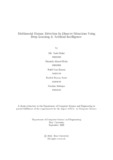| dc.contributor.advisor | Rahman, Dr. Md. Khalilur | |
| dc.contributor.author | Rafat, Md. Tasbi | |
| dc.contributor.author | Hridy, Fahmida Ahmed | |
| dc.contributor.author | Zaman, Rafid Ibna | |
| dc.contributor.author | Santo, Hasibul Hassan | |
| dc.contributor.author | Siddique, Ibrahim | |
| dc.date.accessioned | 2023-02-26T05:30:01Z | |
| dc.date.available | 2023-02-26T05:30:01Z | |
| dc.date.copyright | 2022 | |
| dc.date.issued | 2022-09 | |
| dc.identifier.other | ID: 19101493 | |
| dc.identifier.other | ID: 19101188 | |
| dc.identifier.other | ID: 18301249 | |
| dc.identifier.other | ID: 18301019 | |
| dc.identifier.other | ID: 19101252 | |
| dc.identifier.uri | http://hdl.handle.net/10361/17918 | |
| dc.description | This thesis is submitted in partial fulfillment of the requirements for the degree of Bachelor of Science in Computer Science, 2022. | en_US |
| dc.description | Cataloged from PDF version of thesis. | |
| dc.description | Includes bibliographical references (pages 54-56). | |
| dc.description.abstract | Mankind has faced natural calamities for survival since the very beginning of
human civilization. Even after 65 million years, mankind is still figuring out ways to
face natural calamities and survive its post-consequences effectively. Against natural
phenomena like- hurricanes, tornadoes, earthquakes, building collapse, forest fires,
etc. Humankind is weak and helpless. And no matter how technologically advanced
humankind becomes, nature will always remain the strongest opponent that humans
have to face for their survival. The revolution of science and technology has helped
humankind to invent ways and techniques to survive by fighting against the natural
calamities that they face. Technology can reach into places where humans cannot
and technology can look deep into details that humans can never go through due to
born limitations. Our paper represents the idea of a human detection system that
during any calamity, with the help of multiple detection sensors and thermal visual ization techniques, can detect trapped human beings. This human detection system
combines the knowledge of Machine learning and Artificial intelligence system tech niques. We hope to contribute to saving human lives during natural calamities and
help them to overcome its aftermath in the quickest possible time. | en_US |
| dc.description.statementofresponsibility | Md. Tasbi Rafat | |
| dc.description.statementofresponsibility | Fahmida Ahmed Hridy | |
| dc.description.statementofresponsibility | Rafid Ibna Zaman | |
| dc.description.statementofresponsibility | Hasibul Hassan Santo | |
| dc.description.statementofresponsibility | Ibrahim Siddique | |
| dc.format.extent | 56 pages | |
| dc.language.iso | en | en_US |
| dc.publisher | Brac University | en_US |
| dc.rights | Brac University theses are protected by copyright. They may be viewed from this source for any purpose, but reproduction or distribution in any format is prohibited without written permission. | |
| dc.subject | Natural calamity | en_US |
| dc.subject | Survival | en_US |
| dc.subject | Artificial Intelligence | en_US |
| dc.subject | Machine learning | en_US |
| dc.subject | Detection System | en_US |
| dc.subject | Deep Learning | en_US |
| dc.subject.lcsh | Machine learning. | |
| dc.subject.lcsh | Artificial intelligence. | |
| dc.title | Multimodal human detection in disaster situations using deep learning & artificial intelligence | en_US |
| dc.type | Thesis | en_US |
| dc.contributor.department | Department of Computer Science and Engineering, Brac University | |
| dc.description.degree | B. Computer Science | |

